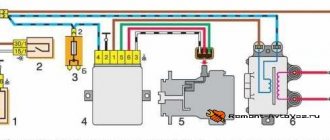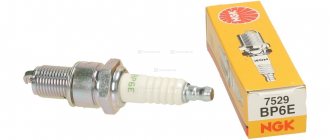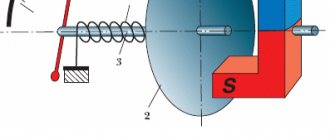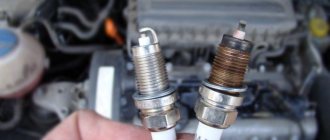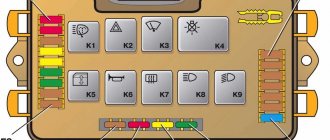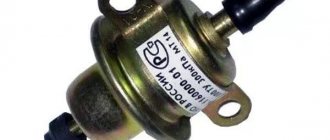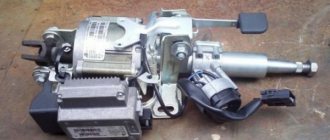Materials from which modern spark plugs are made
Many modern manufacturers of these parts are constantly improving their products, making spark plug electrodes from various materials. Therefore, some may be expensive, while others are designed for the budget class.
But the operating principle of these engine elements remains unchanged; a strong current passes through them, forming a spark that ignites the combustible mixture created in the combustion chamber.
The main elements of candles are electrodes, between which a spark is formed; they are made of metal. Therefore, in some cases, their service life directly depends on the electrode material from which it is made. Therefore, the answer to the question of how often to change spark plugs lies in this plane. That is, this process directly depends on what metal the electrodes are made of.
To figure out how long it takes to change these parts, you need to not only carefully study the instructions, but also listen to the signals that come from the power unit during its operation.
Classification of spark plugs according to the material of their electrodes:
- metal candles, their main elements - electrodes, are made of simple metal that does not have any additional coating, these parts are characterized by a budget cost, so they have to be changed more often;
- iridium, platinum spark plugs, their electrodes are made of metal, the surface of which, under special conditions, is coated with iridium or platinum; they are expensive, but their service life is much longer.
Now let's look at how often you need to change spark plugs made using iridium or platinum.
According to the technical data that manufacturers establish for them, the service life of such spark plugs is 100 thousand kilometers.
Now let’s look at how many kilometers it is necessary to change spark plugs made of simple metal.
Manufacturers set a barrier of 30 thousand km of engine mileage.
But, despite the stated technical indicators, every car enthusiast should understand that this period or mileage can be reduced if the engine runs on poor (poor quality) fuel, or under increased loads. It is also necessary to replace these elements if you buy a used car.
It is important to remember the most important advice. When purchasing spark plugs, the car owner should carefully read the instructions for their use. It will necessarily indicate the mileage that the car must travel before the spark plugs are completely replaced. Even if, after passing this distance, the car enthusiast sees that the spark plugs are in normal condition, in any case they must be completely replaced with new ones.
Spark plug manufacturers
Below, we will present each spark plug manufacturer separately to make it easier for you to choose.
- Spark plugs A-17DVRM Engels - spark plugs from this particular manufacturer are installed directly from the factory and have a service life of 30 thousand kilometers. In general, they more than earn their value, however, judging by the reviews, sometimes there are defects among them, so before purchasing them, it is best to check them.
Candles that are installed directly from the factory.
Reliable spark plugs that have proven themselves in operation.
Optimal price-quality ratio.
Before buying spark plugs, ask the seller to check them on a special stand for the presence of a spark and no breakdowns.
When it is necessary to change spark plugs, even if they have not served their intended lifespan
In our country, the majority of motorists use used cars, the power units of which have worked out a significant resource. Poor quality fuel, defective spark plugs, and other factors (for example, low current) can affect the quality of operation of these parts.
If the driver begins to notice malfunctions in the engine, which will be discussed below, then these parts will have to be replaced, and such work will have to be done immediately in order to protect the entire power unit from major damage.
Signs of engine operation in which the spark plugs require replacement.
- The engine doesn't start well. If a car owner begins to notice that his power unit, after a long period of inactivity, either constantly starts up, not immediately, but after some manipulations with the ignition switch, then the car is giving a signal that cleaning or replacing the spark plugs is required. This behavior is caused by the fact that the spark formed between the electrodes has weakened and does not completely ignite the combustible mixture, or does not ignite it at all.
- The engine is tripping. If, while driving or accelerating, a motorist feels the engine is not working properly, this should tell him that the piston system is not working correctly, that is, some pistons do not provide force to the crankshaft. And this means that in some combustion chambers, the mixture does not ignite.
- Presence of black exhaust gases. This circumstance indicates that the amount of incendiary mixture involved in the movement of the piston increases sharply. That is, due to improper operation of the spark plugs, their sparks do not ignite the entire mixture that accumulates in the combustion chamber. If there is a large amount of it, detonation occurs, which leads to the formation of black smoke. But that is not all. Severe detonation destroys the surface of the pistons and cylinders.
- The presence of a significant amount of liquid in the catalyst and exhaust pipe. If you look closely at the exhaust pipe while the engine is running, you will notice that a certain amount of condensate flies out of it. In ideal condition, condensation always forms, but if liquid literally flows from the exhaust pipe, then this is a signal that not all fuel is burned. If this happens, it means that a weak spark does not ignite the combustible mixture at all, or its combustion does not occur in full.
- Loss of power. If, while driving, a car enthusiast begins to feel that his car is not picking up speed well, or is driving jerkily, it means that the power unit is sending a signal about poor performance of the spark plugs.
This is when you need to change spark plugs if, according to the manufacturer’s technical requirements, they have not yet exhausted their service life.
It is important to remember that without the normal operation of the ignition system, the engine will not only lose power. In its depths, a high temperature will arise, which is formed from the combustion of a combustible mixture exceeding the established volume, and this will destroy the piston rings and allow oil to enter the combustion chamber.
Spark plugs must be replaced after they have reached the end of their service life. If a car enthusiast begins to notice improper engine operation and loss of power, then this is also a signal to replace them. Otherwise, the power unit may become unusable, or its repair will be expensive.
Spark plugs are used in a car to create the spark necessary to ignite the fuel-air mixture in the cylinders of the power unit. Poor spark plug performance due to carbon deposits and other reasons can cause uneven engine operation. Today we will look at the question of how often you need to change spark plugs and what determines their correct operation.
Candles must be selected taking into account the recommendations of the company that manufactured your car. The question of how long the spark plugs last is of interest to almost every car enthusiast; there is no definite answer to it. You need to understand that if we are talking about a new car, then its owner must undergo regular maintenance. As a rule, the first maintenance must be completed after 10 thousand kilometers traveled. During the procedure, specialists also change the spark plugs.
When to change spark plugs can also be determined by the absence or presence of carbon deposits. If you see that a lot of carbon has already accumulated on the spark plug, it must be replaced immediately, and the service life of the spark plugs does not matter in this case.
WHAT TO DO IF IT'S FLOODED?
Every car owner should know what to do when the spark plugs are flooded. Most often, motorists encounter this problem when operating a vehicle in the cold season. In such cases, purging the motor will help. To do this you need to have with you:
- Candle key. Let me dwell on this in more detail. There are many of them in retail chains; any customer request can be satisfied. You can choose the simplest tubular one, the price of which is a little over 80 rubles. Or buy expensive keys with cardan shafts, at a price of 300 rubles apiece. Good reviews are received by such models as a key with a T-shaped handle FIT 63745, keys with cardan models FIT 63747, VIRA 511045, or this one.AIRLINE AK-S-01;
- Spark plugs, preferably new ones;
- Charged battery.
Candle keys
Next steps will be as follows:
- Remove the protective casing on the engine (if equipped);
- Disconnect high-voltage wires from ignition devices;
- Turn them out of the cylinder head;
- Disconnect the wires from the ignition unit;
- Press the gas pedal to the limit and crank the engine with the starter for about 7-10 seconds;
- Now you can put the candles;
- Connect high voltage wires. Each wire fits a specific spark plug, try not to confuse them;
- The connector from the ignition unit is put in place.
Now you can try to start the engine. Some drivers warm up “flooded spark plugs” using accessible methods.
When to change spark plugs - determining factors
The frequency of replacement of spark plugs is determined taking into account various points. Below, only the main ones will be considered. First of all, it is worth noting that the service life of original products is several times longer than the service life of “non-original” ones. Many branded spark plugs work even 50 thousand kilometers without problems, but for third-party products this is unrealistic.
The service life of spark plugs largely depends on the quality of the fuel.
Those who constantly fill their car with low-quality gasoline change the spark plugs quite often. Since low-quality fuel is very common in our country, many drivers regularly wonder how long to change spark plugs. As a rule, this procedure must be performed every 20,000 - 30,000 kilometers traveled.
Experienced car owners can easily determine when to change spark plugs. The sound and operation of the engine changes, an incomprehensible noise occurs, as well as vibration, in some cases the car even begins to twitch.
In addition, the condition of the spark plugs depends on how well it is carried out, as well as the product itself. Low-quality oil often leads to the rapid appearance of carbon deposits on spark plugs, which negatively affects their service life. An excessively high or low oil level in the engine can lead to similar results.
WHAT ARE CAR CANDLES
A spark plug is a small part of a car engine that creates an electric spark that ignites the fuel-air mixture. Using a spark, it creates a mini-explosion in the cylinder, due to which the piston begins its movement. The number of such mini-fuzes in the engine is determined by the number of cylinders. Ordinary business class cars, and in particular VAZ 2114 cars, have four-cylinder engines, which means there are 4 units installed in it. But there are elite class cars or sports cars. They have six- to eight-cylinder internal combustion engines, respectively, 6-8 pieces are installed.
Let's look at the spark plugs for the VAZ Samara. As mentioned above, 4 pieces are installed in the VAZ internal combustion engine. Each consists of a nickel housing, a contact rod protected by a ceramic insulator. A spark occurs when the central and side electrodes come together.
It is important that all 4 candles work synchronously, which means they must be from the same manufacturer and the same brand, that is, from the same materials. It is not advisable to replace one or two spark plugs. If it’s time to change, then it’s better to have all 4 at once.
Frequency of replacement of spark plugs - practical advice
You need to understand that as the number of kilometers a car runs increases, spark plugs have to be replaced more and more often. The reason for this lies in the fact that all materials are subject to wear, which is why spark plugs are being replaced more and more often.
To extend the life of spark plugs, you must adhere to the following recommendations:
- Try to refuel only with high-quality fuel, and do not use the services of dubious gas stations.
- Constantly monitor the oil level in the car's power unit.
- Buy only original spark plugs that are perfect for your car.
- Periodically clean the spark plugs from carbon deposits.
- Pay enough attention to caring for all components of the car, since you are using a single mechanism in which all systems are interconnected.
Now you know how often to change spark plugs, all you have to do is buy the right products and feel the improvement in the performance of your car’s engine. We wish you success!
There are different opinions among motorists regarding the service life of spark plugs. Some take the position that it can handle 20,000 km (and this is an average). After how many km, when should you change the spark plugs? Some are convinced that it can easily cover a hundred thousand kilometers. Experts also do not adhere to a clear verdict. And this is not surprising, since there is no specific indicator here. And the question of replacement frequency remains unresolved for many, because the service life of spark plugs varies. Replacement can be made based on the following aspects:
- terms from the company that produced the car,
- degree of wear of each part.
Also, the replacement of these components often occurs on the basis of their actual conditions. And some car enthusiasts are convinced that it is necessary to carefully follow the recommendations of professionals. How often should you change spark plugs? Others insist that if the ones already installed are in normal condition, and the engine starts at different temperatures, then it is correct to replace them at least after 90,000 km.
This is exactly how long it takes to change spark plugs.
It is also very important to realize what carelessness and ignoring the time of that very replacement leads to.
When to change spark plugs
The meaning of a candle in a power apparatus
Thanks to it, a spark is formed. The spark contributes to the ignition of the flammable composition in the engine cylinders. This process occurs because a high voltage discharge occurs through the electrodes. And yet, how often should you change spark plugs?
Structure
They are formed by several components:
- Output element. Through it, the spark plug is connected to the high voltage line.
- Insulator. It protects against excessive heating. Its ribs prevent damage to the entire surface. And between the center electrode and the side electrode the impulse, the spark, moves.
- Special seal. It prevents fuel from penetrating from the combustion compartment into the engine housing.
Key Features
Here, the leading place in importance is occupied by the distance (electrodes). It is also called gaps. Its size affects the efficiency of ignition of the combustible composition. The wider the parameter, the higher the power of the generated spark. And with a high-quality spark, the scale of the ignition area will increase. This way, the engine in the car is guaranteed to run smoothly and fuel consumption is stable. How can you tell when it's time to change your spark plugs?
If the parameter is modest, then a premature spark appears. And at low voltages a breakdown occurs. As a result, the power and efficiency of the engine decreases.
The second most important is the glow indicator. It reflects the highest temperature loads. The usual indicators for domestically made products are: 8, 11, 14, 17, 20, 23, 26.
Western analogues have slightly different dimensions. These products come in two varieties: hot and cold.
After installing very cold parts with a powerful heat index, the self-cleaning of these parts will be poor. And the engine will work intermittently.
The frequency of replacements is influenced by the conditions and advice of specialists. Very hot ones can lead to glow ignition. The consequences of this are quite devastating. This looks like detonation.
Materials and potential
Before determining replacement frequency, you should classify these parts into two market categories:
- Platinum.
- Simple.
The candle operates in an insulated block. Without removing it from there, it is difficult to study the degree of its wear. How many spark plugs are there in a car? Car manufacturers advise changing them during a regulatory technical inspection. As a rule, this is carried out at intervals of 10,000 - 15,000 km, this is the service life of the spark plugs. This operation is very relevant for a simple type. But often this parameter is applicable for products from the second category. Although replacing expensive spark plugs can also be considered as a way for service centers to gain some financial benefit.
The best factor to understand when to replace is condition.
Experienced car owners can calculate wear and tear by the number of kilometers. For example, replacement should be carried out every 20,000 - 30,000 km, this is the period for replacing spark plugs. The catalog of every decent manufacturer indicates specific times, or rather distance intervals. From the simple category they change after 20,000 km. How long do the best spark plugs last? Platinum products in the area of 99,000 km.
Replacing spark plugs in a car: Three signs that it's time to change them
Previously, all drivers were experts: how to clean a spark plug, set the gap, check whether current is flowing to it. Nowadays, almost no one looks so deeply under the hood. And he does the right thing when we are talking about the most modern cars, where half the engine needs to be disassembled to remove the spark plug.
The old fashioned way
About twenty years ago, if the engine did not start, the drivers themselves always diagnosed what was wrong. When the car responds to the turn of the key with the lights on the dashboard turning on, the engine rotates with the starter, but does not “seize,” which means there is no fuel flowing or there is no spark in the spark plugs. On still carburetor engines (and starting from the 90s, carburetors were replaced by different types of fuel injection, now electronics do this), the ignition was checked by pressing the unscrewed spark plug to the metal part of the engine and turning the key in the ignition switch. If the spark jumps, it means there is ignition, we need to look for a problem in the fuel supply. Why do we remember all this? To avoid doing this again: now trying to “look for a spark” the old fashioned way risks serious damage.
— Checking the operation of spark plugs using old methods is a risk of “killing” the ignition module, burning the coil or tip. Therefore, it is more correct to check the operation of the ignition system using computer diagnostics in a good workshop with a competent technician, recommends auto expert Alexander Karabanov.
And yet, if the car is not new and not super sophisticated, you can try to remove the wires from the spark plugs one by one with the engine running and listen to the operation of the engine. When a working spark plug is disconnected, the engine will definitely start to shake more. This is understandable: the whole cylinder is switched off. If you remove the wire from the spark plug and nothing has changed in the operation of the engine, it means that it is not working. Replacing it with a “healthy” one will show whether the candle was the problem. If after installing a new spark plug nothing improves, then you should definitely go to a specialist.
To the store - with a document
Spark plugs are no longer cleaned with sandpaper or a wire brush; gaps are not straightened. They simply throw it away, replacing it with new ones as a whole set. If the workshop said that the spark plugs need to be changed, but they themselves cannot take them to you right away and supply them, it will be faster to buy and bring the part yourself. But going into a store and saying that you need spark plugs, for example, for a 2005 Volkswagen Passat, is the wrong course of action. Even if you name the size and power of the engine, the seller will not always be able to accurately select the spark plugs. Therefore, we take the car registration certificate (CRC), it contains the VIN number, using it, using catalogs, the seller will immediately find the necessary spark plugs.
If the packaging is not trustworthy, wrinkled, dirty, the candles themselves do not look like new, have traces of dirt and damage, you do not need to take them
A spark plug is a delicate thing, and a kit now even for a very simple car costs more than 1000 rubles, so it’s better to pay attention to them
ON A NOTE
Three signs that it’s time to change them
An experienced driver will understand that the spark plugs have served their purpose. On powerful V-shaped engines this is not so noticeable, but with the most ordinary 4-cylinder engines at idle speed, when the car is running, everything is immediately clear. So, replacing spark plugs in a car is necessary when:
* The engine runs unevenly, it is customary to say “troit”.
* Engine power dropped, the car began to accelerate more slowly, they say it “pulls worse.”
* Fuel consumption has increased.
IMPORTANT!
Diagnosis. by color
Some engine breakdowns can be diagnosed by the color of the spark plug. Its “sting” (to be precise, its electrodes) changes color during operation. And this indicates some kind of malfunction. A “healthy” engine has clean spark plugs that are brown or gray in color.
Red (brown) color is bad gasoline. Refuel elsewhere.
Light gray (whitish) color - lack of gasoline, the master will say - “poor mixture”. This is for repairing fuel equipment.
Black thin soot - not enough air gets in. The air filter may need to be changed.
Thick black coating - the candle is “covered” with oil. It's a bad thing, it smells like an expensive engine overhaul.
After what mileage should you change spark plugs?
These values may vary. Their changes are influenced by the quality of the fuel and the condition of the car itself. In cases of regular use of low-quality fuel, the electrodes in the spark plugs may burn out much earlier than their standard life. Symptoms of this are: unstable engine functioning and loss of traction.
If the car runs on simple spark plugs, and the mileage is already close to 80,000 km, the car’s power decreases and its gluttony increases. This is how many km you need to change the spark plugs. And then the driver may come back to haunt him for his forgetfulness or inattention, since such spark plugs had to be replaced about 60,00 km ago. Although it is not uncommon for ordinary cars to operate stably for 30 and 40 thousand km. But it’s better not to tempt fate and make a replacement according to the procedures, focusing on the potential assigned by the manufacturer. The interval after which spark plugs need to be changed is always indicated on the packaging.
Signs of spark plug wear
Signs of wear are sometimes very noticeable, since this device takes part in the direct operation of the engine and ignition of the combustible mixture. Therefore, it is immediately clear when to change the spark plugs. If the car twitches while driving, the starter does not work immediately, and in order to start the car, several idle revolutions are required; if fuel consumption increases and engine dynamics decrease, the time comes when you need to change the spark plugs.
Determining the malfunction and the period after which to change the spark plugs is carried out in several ways. If the car does not start, or does not start immediately, it is worth determining what could be causing this. The malfunction leads to a decrease in engine performance, if when the engine is turned on, an interval or gap appears in the cycle of uniform spark supply - not only its performance is reduced. The volume of evaporation during fuel combustion increases, raw fuel enters the gas exhaust system, which causes overheating and overload in the operation of the catalytic catalyst. It goes without saying that this cannot but affect the condition of the entire system, and then it is necessary to change the spark plugs if it is determined that they are the cause of gaps or pauses.
If there is a gap in the engine operation, the exhaust of unburnt fuel can also cause the catalyst to fail and the engine to stall. The catalyst is not cheap, and only replacing it can correct the situation.
Why change spark plugs for no apparent reason - they directly affect fuel consumption. If carbon deposits form, more fuel mixture will be used with less efficiency. There may also be problems with starting the engine, especially when it is cold outside or after a long period of inactivity, for example in the morning.
We recommend: We independently remove the door trim from the Lada Priora
Symptoms of wear and tear
When should you change spark plugs? People often turn to official centers for replacement services. But even before visiting there, it is important to find out that the time for replacement has already come. Prerequisites for this may include:
- the appearance of vibrations and jerking while driving,
- unstable engine behavior.
Before your diagnostic visit, you can analyze the product yourself
. This can be done if they are easy to remove. How long do spark plugs last?
Signals for replacement may be their appearance and other characteristics.
Gap Study
This procedure takes place first. All candles are specially marked. This marking reflects the type of part and the gap parameter. This is the very last number. It is indicated in millimeters. If the actual gap exceeds the specified value, the device must be urgently replaced.
Presence of soot
Ideally, it is desirable that soot is completely absent. When there are no disturbances in the combustion process, the electrodes clean themselves. When there is black or white carbon deposits on the device, this is a sign of improper ignition. But the quality of the part does not matter here. If there are large differences in the color of the soot and the general appearance, then you should refer to the manufacturer’s documentation, which reflects the frequency of replacing spark plugs. Of course, it must be replaced.
Ceramic insulator
If cracks form in it, they are filled with a brown coating. With this picture, the kit is completely replaced. All advice concerns mileage. As already indicated, for conventional devices it reaches 20 thousand km, for platinum parts - 100 thousand km, these are the recommended spark plugs. Once these parameters are reached, you can safely set new ones. How many kilometers should you change the spark plugs? Here we turn to the recommendations of the company that produced these devices.
Signs of spark plug wear
If you have doubts about the continued suitability of the spark plugs, before carrying out maintenance, you can independently assess the condition of the spark plugs using indirect signs. These include engine vibration (vibration) and uneven movement of the vehicle.
If possible, the candle should be inspected. Sometimes a visual inspection cannot be carried out. For example, in some foreign cars with 8-cylinder engines, in order to inspect the spark plugs, it is necessary to completely disassemble the engine intake manifold, and this is a rather labor-intensive task, especially for a beginner. If the candle was still removed, then it can be checked using the following signs.
Gap between electrodes
When producing candles, they are marked in a special way. In addition to all the information on this marking, you can determine the permissible gap. To find out, you need to find the last digit in the designation; it is the size of the gap in millimeters. It is compared with the real value between the electrodes. If the gap is larger, then the spark plugs need to be replaced.
Not all markings have a gap number at the end; in these cases, the gap is chosen as standard, equal to 0.8 mm.
Nagar
During normal functioning of the spark plugs, carbon deposits should not appear on them, since the electrodes clean themselves. But most often the candles have white or dark soot on them. This does not indicate the quality of the candle. The reason for this may be an incorrectly configured ignition; to correct it, you will need diagnostics on a computer, or regular diagnostics.
It often happens that candles differ from each other: one has carbon deposits on it, or it is wet, the other does not have carbon deposits. In this case, it is better to replace the entire set of spark plugs rather than just one spark plug.
"Clay" insulator
By external visual inspection, you can also determine the degree of wear of the spark plugs. First, we find microcracks with a brown coating in the form of a mesh. This is a clear sign of wear and the need to replace the entire set of spark plugs.
We recommend: Oil leakage from under the crankshaft oil seal: causes and troubleshooting
Another common sign is the appearance of a coffee skirt on the candles. A similar effect occurs from delamination of the insulator and the spark plug body. As a result, combustion products penetrate into the gap between these layers, expanding this gap even further. As a result, a coffee skirt appears on the candle.
This slight delamination is not yet considered a sign of replacing the spark plugs, but if the skirt is large and dark brown, then replacing the set is required immediately.
When deciding on replacement, one inspection is not enough. Mileage is more important here, therefore, if the total mileage of a car with simple spark plugs is about 20 thousand km, then the appearance is no longer so important; they should simply be replaced without finding out other reasons.
Consequences of negligence
How do you know when it's time to change your spark plugs? If the car owner ignored or did not take the deadline seriously, the consequences could be fatal. For example, in an emergency, when a car is urgently needed, its engine may simply not start. Or the car may stop somewhere on the road where there is no technical assistance nearby. Therefore, you should not neglect the standards, but change the spark plugs on time.
Also, do not ignore the symptoms of broken spark plugs, otherwise you will have to repair the engine. And this is quite an expensive activity. The list of fatal breakdowns includes detonation that occurs in the cylinder. A shock wave results and entire charges detonate in the cylinders. When this wave is reflected from the walls of the combustion compartment, a tinkling sound is heard.
In the event of a powerful detonation, the engine weakens and the exhaust fills with black smoke. The motor is overloaded. Pistons and other engine components may be damaged. The cylinder can wear out instantly. To avoid such troubles, do not forget to make a timely replacement. And then your car will serve you well for a long time.
You should not ignore the symptoms of broken spark plugs, otherwise you will have to repair the entire engine.
Spark plugs in internal combustion engines start the process of combustion of the fuel-air mixture in the cylinders, and their performance directly determines whether the performance characteristics of the engine are as stated by the manufacturer.
Misfire even in one of the engine's 4-6-8 spark plugs significantly reduces its power and increases the content of harmful substances in the exhaust gases. The most likely causes of spark plug malfunctions are manufacturing defects or untimely replacement. How often do you need to change spark plugs?
The frequency of replacing spark plugs depends on a number of factors:
- engine design;
- candle making technologies;
- operation of the ignition system as a whole;
- operating conditions;
- fuel used.
For most car brands, the frequency of replacement of spark plugs is prescribed by the manufacturer in the operating manual or service book.
As a rule, for modern engines it is set equal to 30 thousand kilometers. It should be noted that this requirement is valid for high-quality original spark plugs, with a heat rating corresponding to the type of engine. The heat number is a thermal characteristic of spark plugs, showing the temperature limit after which the process of uncontrolled ignition of the fuel-air mixture in the engine cylinders from the hot parts of the spark plug begins to appear. According to their heat rating, candles are divided into hot, medium, cold and unified. There are special tables on the marking and interchangeability of spark plugs from major manufacturers.
If there are no problems with engine operation, adhere to the spark plug replacement intervals recommended by your vehicle manufacturer. Uneven engine operation, noise and vibration can signal a problem with the ignition system in general and the spark plugs in particular.
If the diagnostics of the ignition system does not reveal any malfunctions, then unscrew the spark plugs and carefully inspect them. A properly functioning spark plug should have a light brown soot in the area of the central electrode and its insulator. Black carbon deposits indicate disturbances in the combustion process of the fuel-air mixture due to malfunctions in the ignition or fuel supply system. Soot with a red tint will indicate a large amount of additives in the fuel you are using.
Visually checking spark plugs for the presence of a spark between the central and side electrodes will not give you reliable information about its performance. The fact is that the presence of a spark under atmospheric pressure does not mean that the spark plug will also work under conditions of increased pressure in the cylinders. For adequate testing, special stands are required in which the spark plug is screwed into a chamber with an observation window, into which the required pressure is subsequently applied, and then voltage. Only such a test allows you to accurately assess the performance of the spark plug.
In the absence of such a stand, the only way to normalize the operation of the ignition system is to unscheduledly replace the spark plugs with new ones that are known to be good. Of course, before this, work must be done to identify and eliminate the causes of premature failure of spark plugs.
Do you know how often you need to change spark plugs and in what season is it better to do it? What does the frequency of replacement actually depend on: the length of the operating period or the intensity of travel? At what mileage or after what time after installation is it better to change the spark plugs for new ones? Why do they usually fail? How to determine visually whether they need replacement? And why do maintenance technicians ALWAYS insist on replacing spark plugs?
Read about all this in our article. And first of all, we will tell you why change spark plugs at all when the car runs well on the old ones.
Replacement sequence
Despite its apparent simplicity, this operation should be taken responsibly. Replacement should be made as a complete set (!)
. Partial replacement of one or two “lost” spark plugs is only possible for a short time.
Different gaps and types of spark plugs and their conditions lead to inevitable failure of ignition timing, increased detonation, and contribute to increased engine wear.
The selection of spark plugs should be made for the vehicle based on reference data. You shouldn’t rely on “these are the best” recommendations. It is better to purchase products only from trusted manufacturers.
As the main tool for replacing spark plugs, it is better to use a special long head with rubber inserts to grip the spark plug being removed. Before purchasing it, you should measure the diameter of the mounting hole.
The standard sizes of spark plug heads are 16 and 21. The length of the seating zone can be different, up to 180 millimeters in certain engine models. In some cases, you can use a spark plug tube, but keep in mind that its reliability is less. It’s even worse to use special keys from unknown manufacturers in beautiful packaging. They may break the first time you unscrew them.
Sequence of spark plug removal:
- remove the installed high-voltage wires, having previously noted or photographed the sequence of their installation;
- if the car has individual ignition coils or a coil block installed in the spark plug space, dismantle them (in V-shaped engines this process can be complicated by the need to dismantle part of the intake manifold and other engine elements);
- be sure to check the spark plug installation areas for the presence of foreign objects (when removing the spark plug, fragments of insulation and other objects may fall directly into the cylinder and cause big problems);
- securely install the spark plug wrench, apply medium force, and begin unscrewing;
- if the dismantling process is difficult, it is necessary to use special means for decoking the threaded connections, and do not try to apply excessive force;
- remove the spark plug (if the retaining rubber band has come off, you can do this using the tip of a high-voltage wire);
- It is better to install a plug or throw a clean rag on the vacated spark plug hole (there are many cases when, during the repair process, nuts, washers and other “surprises” get there, that is, into the cylinder).
Video - replacing spark plugs for Renault Logan and Largus (8 valves):
New ones are installed according to the following rules:
- first, use a clean rag to clean the installation area from oils and dirt (if this place is inaccessible for visual inspection, it is better not to do this: trying to remove contamination from above the threaded connection, you can redirect it to the thread);
- when installing new ones, you must once again check that the seating depth of the spark plug matches the old one;
- The initial direction of the spark plug into the seat is done carefully using a spark plug wrench; you should not “throw” the spark plug, this may change the gap;
- preliminary tightening should be done with a slight force; if movement is difficult, you need to unscrew and start tightening the spark plug again;
- the final “squeezing” of the spark plug is done with medium force (at service stations, a torque wrench is used for this; the tightening torque is set in the range from 15 to 35 Nm, depending on the thread diameter and type of fit);
- The last stage of installation of spark plugs is the installation of high-voltage wires.
Why change working spark plugs?
Why replace spark plugs with new ones if the old ones work well? This question has always been relevant. Because the desire to at least partially save on consumables has become firmly attached to the mysterious Russian soul.
Previously, men spent all weekends in garages, tightening something, sorting it out, adjusting it. In order to change spark plugs less often, they were systematically unscrewed, dried at home on the stove, cleaned, and the electrode was bent. Now there is a different generation of people and cars, and few people are ready to spend personal time on car repairs and maintenance.
However, the stability of the engine largely depends on the condition of the spark plugs. And the fact that they are still working does not mean that they are fully operational. And while you think that everything is fine, irreversible processes can occur in the engine. We will tell you which ones and why below.
WHAT CANDLES TO CHOOSE FOR VAZ 2114
The auto parts market provides a fairly wide selection of igniters for the VAZ 2114. There are Russian manufacturers, Western European ones, and, of course, Japanese ones. Below you will find out which spark plugs for Samara models are preferred by the owners of these cars.
- DVRM AU17 from Engels is installed by the VAZ manufacturing plant itself on its cars. The plant recommends these spark plugs for VAZ 2114 to car owners of its models. Car enthusiasts themselves believe that DVRM are good igniters for these cars. True, according to the same car owners, sometimes they come across a defect. Therefore, before installation, it is necessary to check the functionality of the spark plugs on a stand. On average, a set of 4 pieces costs about 200 rubles.
- Czech Brisk spark plugs have also proven themselves to be reliable and are in demand among VAZ 2114 owners. This manufacturer produces 10 types for different models of foreign cars, including motor vehicles. They cost about the same as Russian DVRMs.
- DENSO Japanese candles do not require special recommendations. Many foreign car factories install them on their car models. True, they are much more expensive than domestic and Czech brands - 350-400 rubles per set, but they also promise to last much longer than their European and Russian counterparts.
It’s up to you to decide which spark plugs to put on the VAZ 2114 – expensive or cheap, branded or just popular. The main thing is that they match your engine type and work properly.
What does a spark plug consist of and what functions does it perform?
So, a little theory! If anyone doesn’t know, a spark plug is necessary to ignite the fuel-air mixture in the engine cylinder. That is, as many cylinders as there are spark plugs. The spark plug consists of 6 main parts. Each of them has its own function.
Proper operation of the spark plug ensures efficient combustion of fuel in the engine, saves fuel and protects the engine itself from premature wear.
At the same time, the candle itself is forced to remain in extreme conditions and withstand such phenomena as:
- heat
- high pressure
- electrical voltage
- spark impact
And deposits often appear on the spark plug due to low-quality fuel. Or due to the presence of various additives in fuel and oil.
Sooner or later, any of these factors will lead to spark plug failure. Sometimes this happens gradually (for example, carbon deposits form), sometimes instantly (breakdown occurs).
What happens if you don't change the spark plugs on time?
If at least one of the spark plugs does not work correctly, it immediately begins to harm the car. Moreover, because of a single spark plug you can end up with very expensive repairs.
So, possible problems and their consequences:
- A change in the size of the gap between the electrodes of the spark plug (melting of the electrode, its burnout, the appearance of soot) leads to a weakening of the spark, misfire and the so-called engine tripping. Triple is when one of the cylinders does not work correctly or does not perform its functions at all; the engine itself vibrates strangely, misfires occur, and popping noises are noted in the exhaust system.
- A weak spark reduces the combustion efficiency of the fuel mixture.
- The resulting carbon deposits or dirt accumulated on the electrodes threatens breakdown of the coil and failure of related parts of the ignition system.
- Misfire increases detonation in the cylinder, accelerates the development of corrosion of the cylinder walls and pistons, and provokes the formation of sediment in the working fluid. There are difficulties starting the engine in the cold.
In some cases, the car owner’s reluctance to change one spark plug results in a major overhaul of the entire cylinder block. And due to detonation in the cylinders, the crankshaft may suffer. The integrity of connecting rods and pistons is not even discussed.
Do not forget also that long-term use of a spark plug without preventive unscrewing is ideal conditions for coking of the threaded connection. And this is again a major overhaul or complete replacement of the unit.
How often to change spark plugs
How often you need to change spark plugs on a particular car is usually indicated in the documents. For your convenience, the manufacturer prescribes what brands of candles he recommends using and how often replacement should be made: after what time or mileage.
In principle, a lot depends on the type of candles themselves. For example, platinum ones are replaced after 50-60 thousand km, and iridium ones - after a mileage of 100 thousand km. But these are more expensive and therefore rarely used. Usually cars have classic ones that require replacement after 10-20 thousand kilometers. By the way, under favorable conditions and periodic cleaning, they can cost the same 50 thousand.
And even if your papers indicate 50 thousand km, and you have driven no more than 15 in a year, at the next maintenance you will still be asked if you would like to change the spark plugs. And they will do the right thing.
Experienced motorists and service technicians agreed that spark plugs should be changed once a year. And this should be done in the fall in preparation for the winter period.
Why in autumn?
As the weather worsens (ice and snow), the operating conditions of the vehicle deteriorate sharply. And negative temperatures play an important role. All systems, including the ignition, work under increased load during the winter season and will certainly fail if there are problems. Therefore, by winter the car should be at the peak of its capabilities.
So before the start of winter, spark plugs should at least be inspected, cleaned, and ideally replaced with new ones. And not one or two candles, but a complete set at once.
Spark plugs are the same consumables; it’s stupid to waste money on replacing them. Still, once a year is not so often.
HOW TO CHANGE PLUGS IN A CAR?
Changing spark plugs in a car is not difficult; any car owner can handle this operation on their own.
If you decide to replace them off the road, then let the engine cool. Otherwise, you can burn yourself and damage the thread when unscrewing, since the heated metal expands.
- Open the hood; if you have a protective cover, you need to unscrew it and remove it. The contacts are equipped with protective caps with high-voltage wires. They must be carefully removed, holding them by the caps, but under no circumstances pull on the wires. You can break the connections, and then you will have to change the wiring.
- Around the ceramics from the nest, it is necessary to remove all carbon deposits and debris that have accumulated here. Otherwise, all this dirt may end up in the engine cylinder.
- To remove the spark plugs, carefully unscrew them with a wrench. Having moved from the dead point, try to unscrew it. Do not rush, you can damage the threads of the socket or body. Try screwing it in again a little, and continue turning it out carefully.
- After unscrewing the old spark plug, clean the threads from dirt with a rag. Screw in the new one. When you feel that the thread is tight, make a quarter turn, but do not overtighten, otherwise you may ruin the thread of the cylinder, or the element itself.
- Place the high-voltage caps on the contacts, replace the casing, and close the hood.
Replacing spark plugs with 8kL
For the first two or three days, observe how your new thing works. It is possible that a defect may occur, then the engine will operate intermittently. If this happens, you can determine which spark plug is defective by sequentially disconnecting the wires. Be sure to replace the rejected part.
How do you know when it's time to change the spark plugs?
How often to change spark plugs is determined not only by the mileage of the car, but also by the condition of the spark plugs themselves. There are a number of signs indicating possible faulty spark plugs:
- Strong smell of gasoline from the catalyst (indicates that the fuel is not completely burned).
- Increased fuel consumption (due to misfire).
- Difficulty starting the car engine.
- Unstable engine operation (troits, stalls, gains speed poorly, shows reduced power, jerks). Sometimes detonation and other extraneous sounds are also clearly audible.
- Change in the nature of the exhaust gases (soot and odor appear, and the analyzer will show increased CO).
- Visual defects of the spark plug (cracks, chips, melting, uneven color of electrodes, carbon deposits).
- The “CHECK ENGINE” signal lights up on the dashboard.
If any of the above is observed in your car, it is advisable to check the spark plugs.
When it’s just a matter of carbon deposits, you can clean it off, and then the candles will work for some more time. If the spark plug is covered in oil or has a strange coating, it makes sense to change the brand of oil and start refueling elsewhere. If the spark plug shows obvious signs of destruction, definitely replace it!
Signs of incorrect clearance VAZ 2114
How often to change spark plugs in a gasoline engine
More or less distance leads to rapid wear of the engine. It negatively affects the driving performance of the car. The signs of this problem are usually the following:
- Increased fuel consumption. The car has to be refueled more often than before. At the same time, it may seem that she began to drive better and faster. This indicates an increased spark plug gap;
- Increased car dynamics. The car began to accelerate faster and began to seem more resourceful. At the same time, gasoline consumption is also increasing. This can be seen by sensations and instrument readings. The symptom indicates too much distance;
- Reduced power and dynamics. The car doesn’t seem to be able to pull, it’s getting worse to drive and accelerate. This occurs due to the value of this value being too small;
- The engine is tripping. In this case, the car shakes or the engine shakes. Observed at idle and not only;
- Floating speed. The speed of the power unit is unstable and changes for no apparent reason. This can be seen from the readings on the dashboard;
- Traces of oil in the spark plug well. They can be seen upon examination;
- The engine suddenly stalls at idle and when driving. The engine stops working for an unknown reason;
- Difficulty starting the power unit. It starts very poorly, not the first time. Sometimes the engine may not start at all.
It is not prohibited to operate the machine with incorrect spark plug distance. But driving with such a disadvantage leads to serious damage to the power unit, requiring complex repairs. And driving with this problem is uncomfortable. Therefore, it must be eliminated within a reasonable time.
Guess which spark plug is faulty
It often happens that the engine stalls or simply malfunctions, but all the spark plugs appear to be in good working order and even without soot. What to do in this situation if you don’t want to change the entire set at once?
Just alternately disconnect each of the spark plugs from the electrical wiring and observe the behavior of the motor, listen. That spark plug, the disconnection of which does not change the operation of the engine, is the source of the problem.
True, it is not always the spark plug that causes engine problems. But after the replacement, you will understand that the issue is definitely not the spark plugs.
Factors that reduce spark plug life
So, factories give us complete information about how often the spark plugs in a car need to be changed. BUT! In their recommendations for replacement, manufacturers are based on the normal operating conditions of the car and the spark plugs themselves. However, there are a number of factors that significantly accelerate the wear of spark plugs and, as a result, their failure. Here they are:
- Poor quality fuel or oil.
- Incorrect ratio of gasoline and air (the reason may lie in a decrease in compression, breakdown of the flow meter, lambda probe).
- Malfunction of the injector.
- Oil entering the working volume.
- Misfire.
- Incorrect ignition angle.
- Old age of the car. In older cars, engines are less stable than in modern models.
- Gaseous fuel. The combustion temperature of gas is a third higher, so in cars that run on gas, spark plugs should be changed almost twice as often.
- Using unsuitable spark plugs.
Electrode gap size
When spark plugs are manufactured, they are marked in a certain way; among other information, such markings can be used to find out the gap standard. Look at the last number in the row of markings (the value is indicated in millimeters) and compare whether the actual spark plug electrode gap corresponds to the indicated value. If the gap exceeds the specified value, the spark plug must be changed urgently.
We recommend: How to properly flush a carburetor to restore its functionality: methods and means
In some cases, the last digit may be missing from the marking, this indicates that the gap is taken “by default” and should be equal to 0.8 mm.
Nagar
Ideally, during ignition, carbon deposits should not appear on the spark plugs, given that during normal combustion, the electrodes tend to self-clean. In “not ideal” cases, white or, conversely, black soot can be found on the candles, which is by no means a sign of low quality candles. What is most likely happening here is an incorrectly configured ignition, and in this case it is impossible to do without the intervention of a diagnostician. In cases where the candles differ from each other in appearance, for example, there is carbon deposits on one of the candles or the candle is “wet”, rest assured that the candle is worn out and a complete replacement of the set of spark plugs is required. It is the entire set, and not just a separate spark plug with signs of wear.
Type of ceramic insulator
An external inspection of the ceramic insulator can also indicate the degree of wear of the spark plugs. First of all, microcracks filled with brown plaque are detected. Visually, all this looks like a kind of “grid”. This is a clear sign of wear and the entire set of spark plugs should be replaced.
Another common defect is the appearance of a so-called brown “skirt” on the electrode. This effect occurs due to delamination of the spark plug body and the ceramic insulator. As a result, combustion products penetrate into the gap between the layers, which in turn further enhance the already begun delamination of the body, which ultimately leads to the appearance of that very “skirt”. The newly begun formation of delamination cannot yet be considered criminal, but if the “skirt” already looks quite impressive and is dark brown in color, then such a candle should be replaced without delay.
Is it necessary to use only candles recommended by the manufacturer?
Typically, the manufacturer will list specific spark plug manufacturers, as well as their type, in their user manual. However, markings and type systems may vary depending on the manufacturer. Of course, there are also exclusive options, specially created to order from automakers, intended for exclusive car brands. Perhaps these are more exception cases, and most often (about 98%! types) are produced by major manufacturers, and the labeling system may vary, but the candles themselves will be identical.
Of course, this provides car enthusiasts with a certain freedom of choice. You can use candles from any manufacturer, the main thing is that they correspond to the type and heat rating specified in the instructions. It is even possible to install a candle that is superior in quality to its previous analogue, or is a more modern option. For example, instead of “regular” spark plugs, install a more modern model, that is, developed later than the year of manufacture of the car.
We must not forget that the car manufacturer, when completing the final product, adheres to the principle of “necessary sufficiency”. This means that he will not install a candle worse than required on the car, but at the same time, the option of installing a better model is also rejected due to its high cost. That is why the process of selecting the type of candle seems to be quite creative, because it can only be limited by your financial capabilities.
And finally, if you still have questions about how often you need to change spark plugs or how to choose them correctly, you should not listen only to the advice of more experienced car enthusiasts. The surest and simplest solution is to open the owner's manual for your car and carefully study all the available information.

